May Giveaway – Asian American and Jewish American History Month
May is a great time to learn and share information about Americans of Asian and Jewish heritage!
Use our resources for FREE by signing up. Just send us an email at info@analyticorange.com and request access to our monthly giveaway lesson plans.
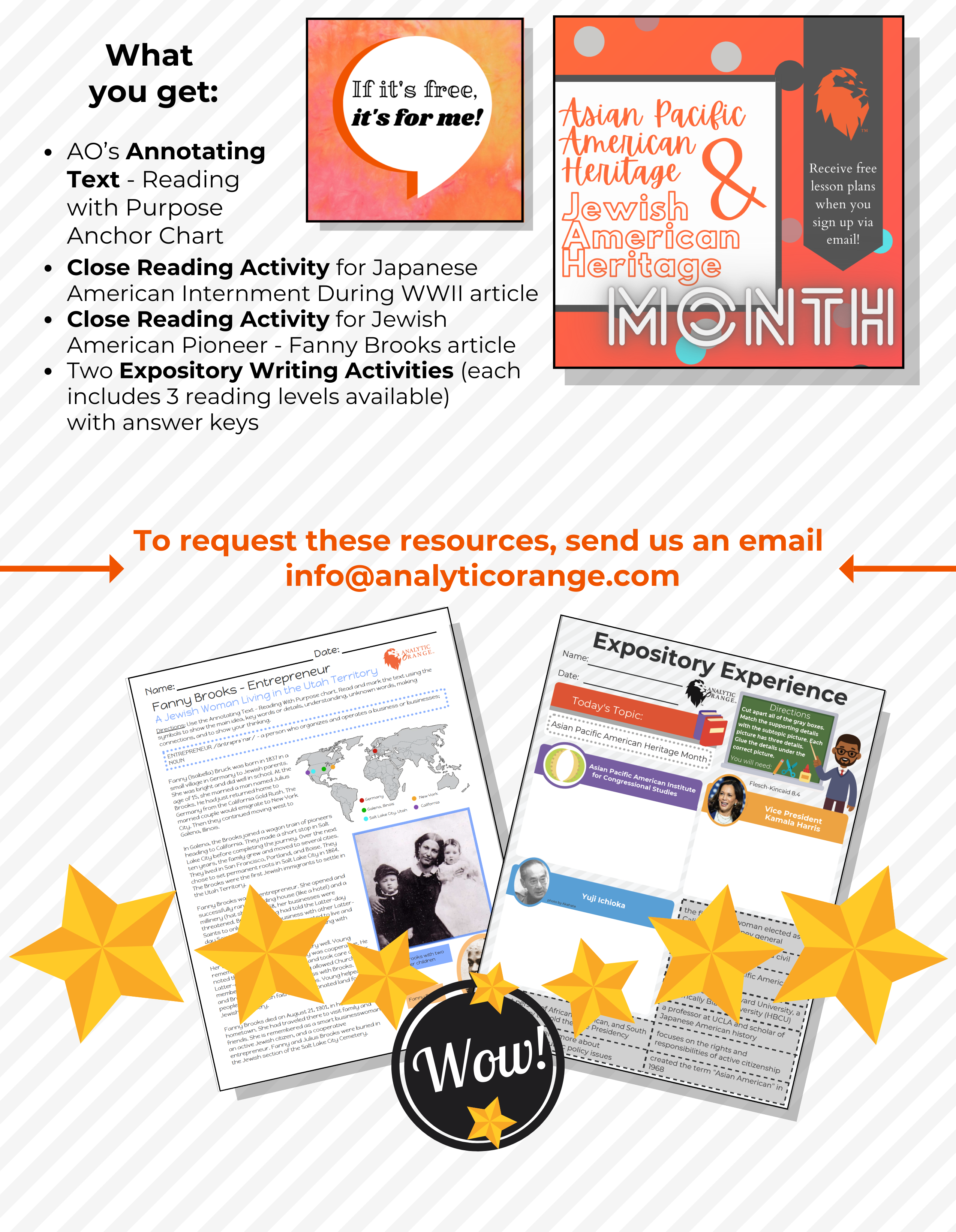
April Giveaway – Poetry in Social Studies
April showers bring May flowers, but April also brings fresh Poetry Month lesson plan resources. If you miss the opportunity to sign up, you can purchase these resources on Teachers Pay Teachers. 
Sign up for our May Giveaway by sending us an email: info@analyticorange.com. Just tell us you want to join our monthly free teaching resources giveaways.
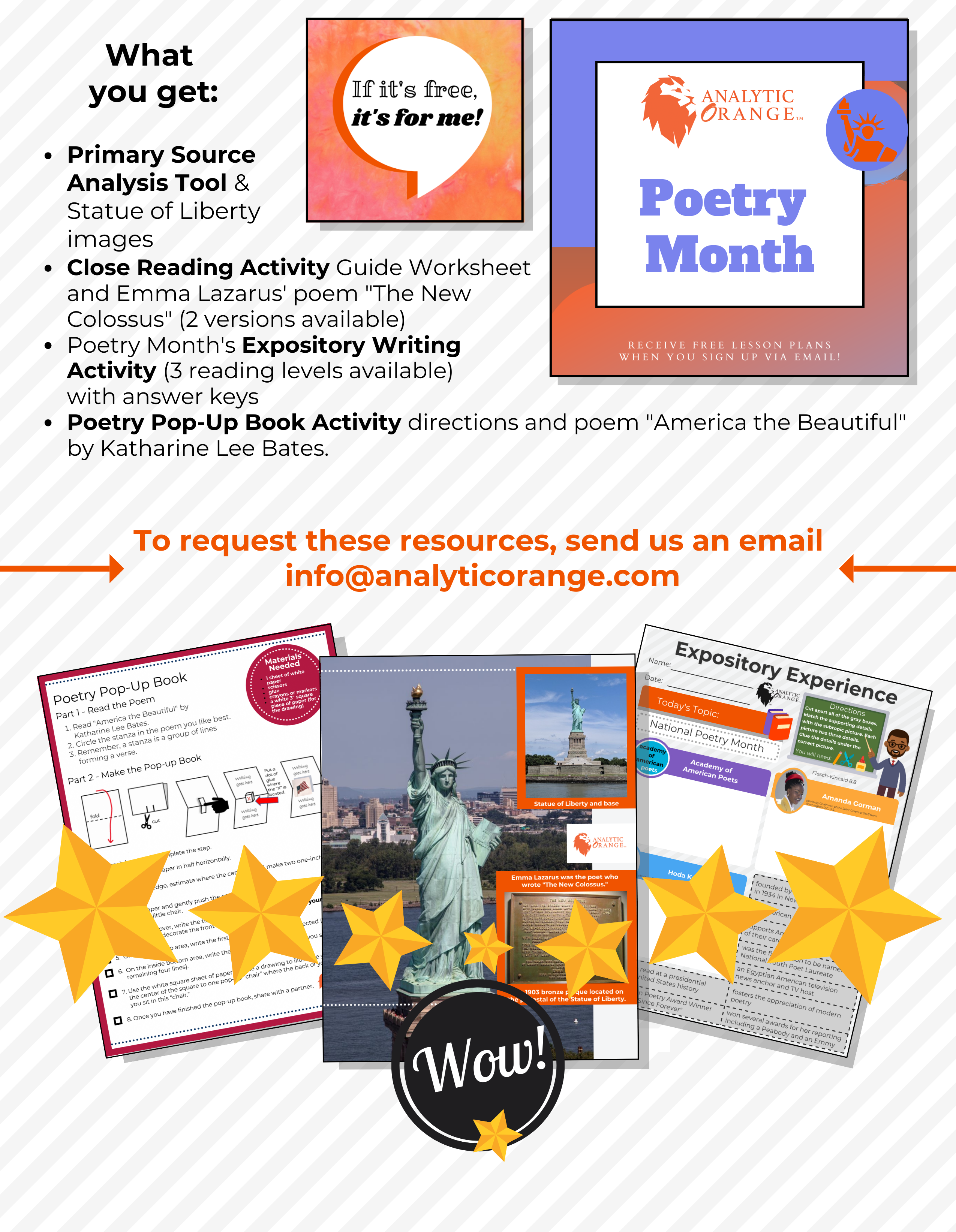
March Giveaway – Celebrate Women’s History Month
Get excited for Women’s History Month! We have gorgeous lesson plan resources. If you miss the opportunity to sign up, you can purchase these resources on Teachers Pay Teachers. 
Sign up for our April Giveaway by sending us an email: info@analyticorange.com. Just tell us you want to join our monthly free teaching resources giveaways.
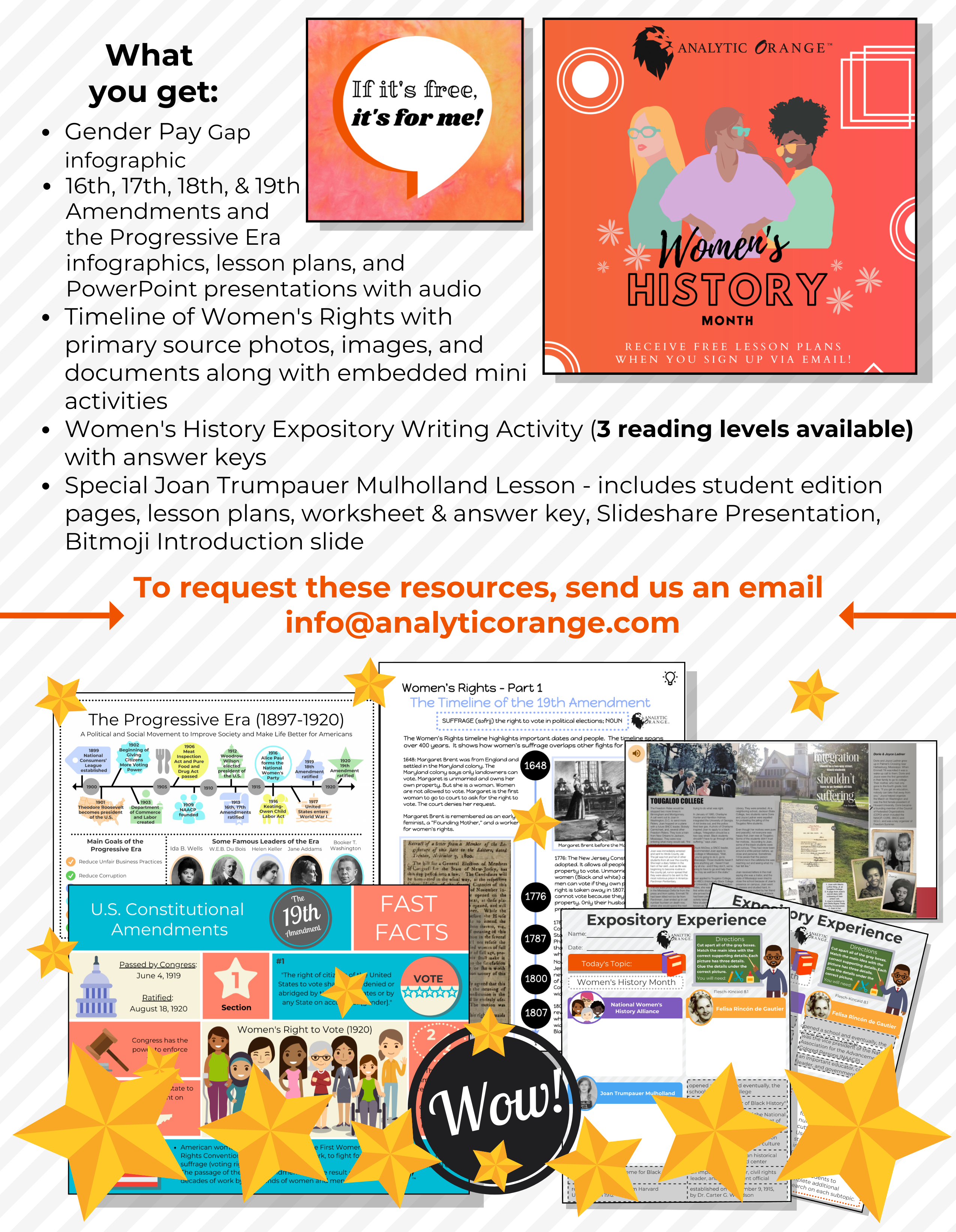
February Giveaway – Celebrate Black History Month
Have your students learn about African Americans’ significant contributions to our country and world. Celebrate Black History Month with our engaging lesson plan resources. Sign up today and find out what makes AO so special. We cannot wait to celebrate with you!
Sign up for our February Giveaway by sending us an email: info@analyticorange.com. Just tell us you want to join our monthly free teaching resources giveaways.

January Giveaway – New Year Traditions
January is a time for fresh starts, learning about New Year Traditions from different cultures, celebrating Martin Luther King, Jr. Day, and Historical Figures with January Birthdays.
Sign up for our January Giveaway by sending us an email: info@analyticorange.com. Just tell us you want to join our monthly free teaching resources giveaways.
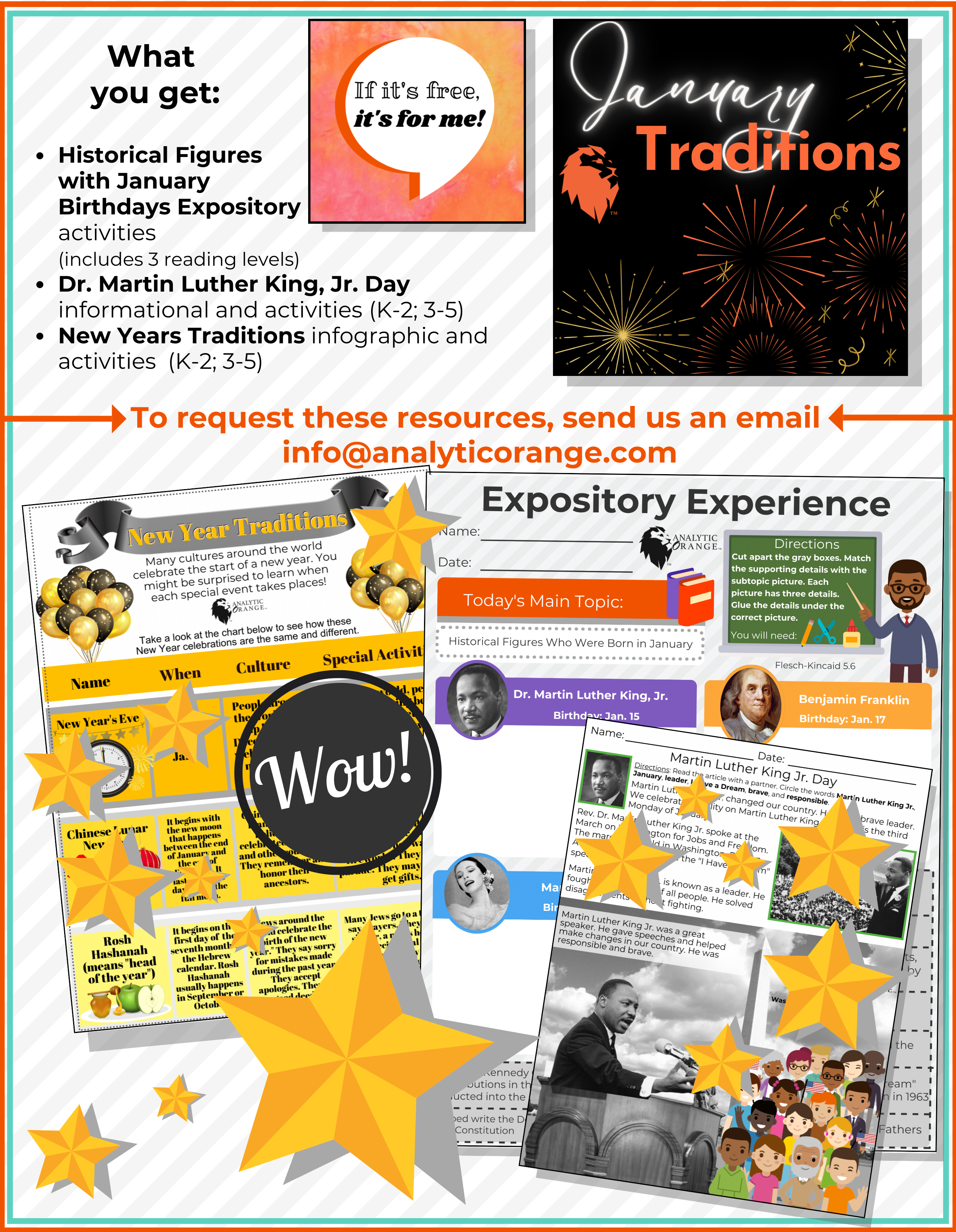
December Giveaway – Holidays of Love & Light
December is a time for celebrating with family and friends, learning about holidays of love and light, historical figures with December birthdays, and Bill of Rights Day (15th)!
Sign up for our December Giveaway by sending us an email: info@analyticorange.com. Just tell us you want to join our monthly free teaching resources giveaways.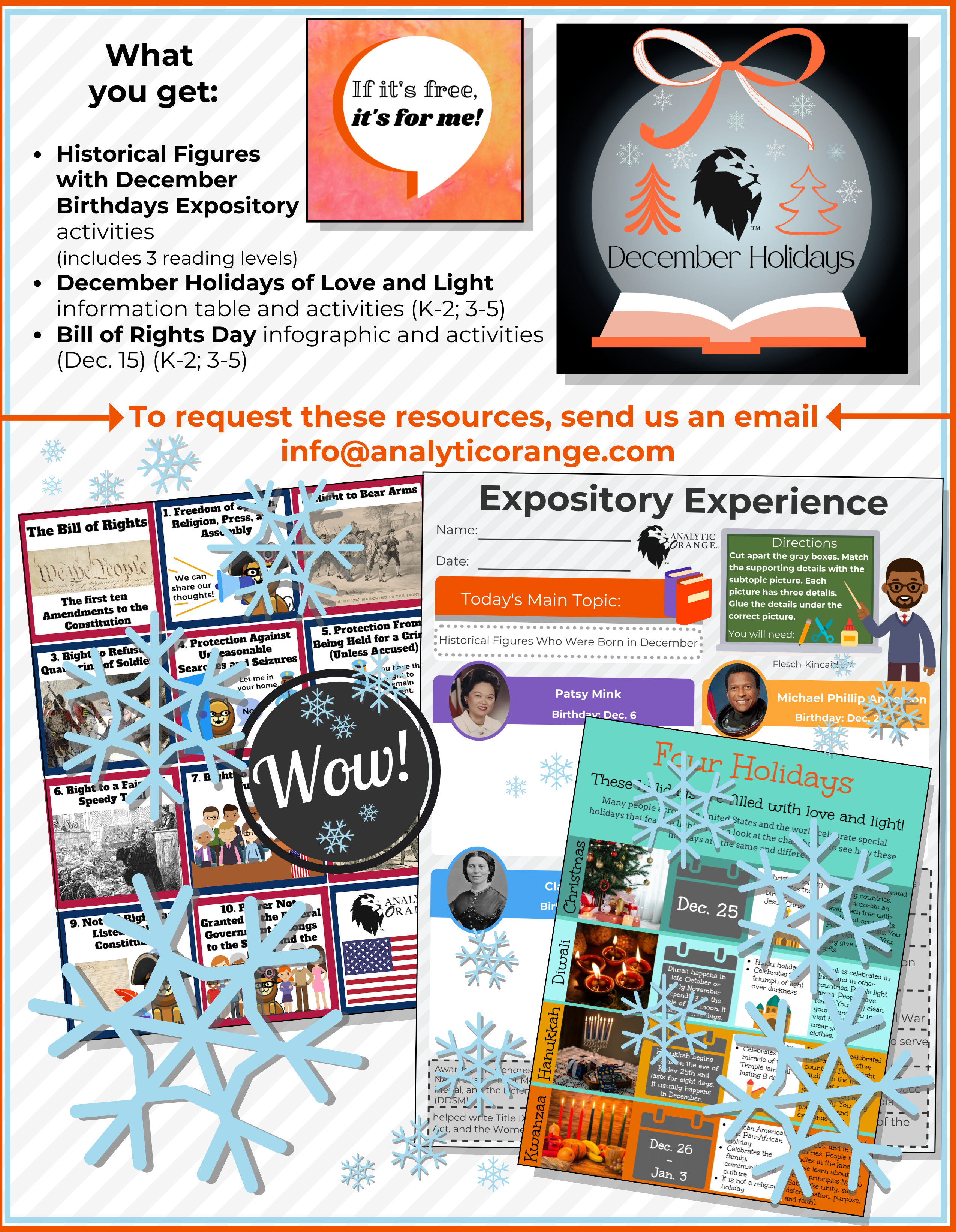
Textbook Award Winner: Analytic Orange
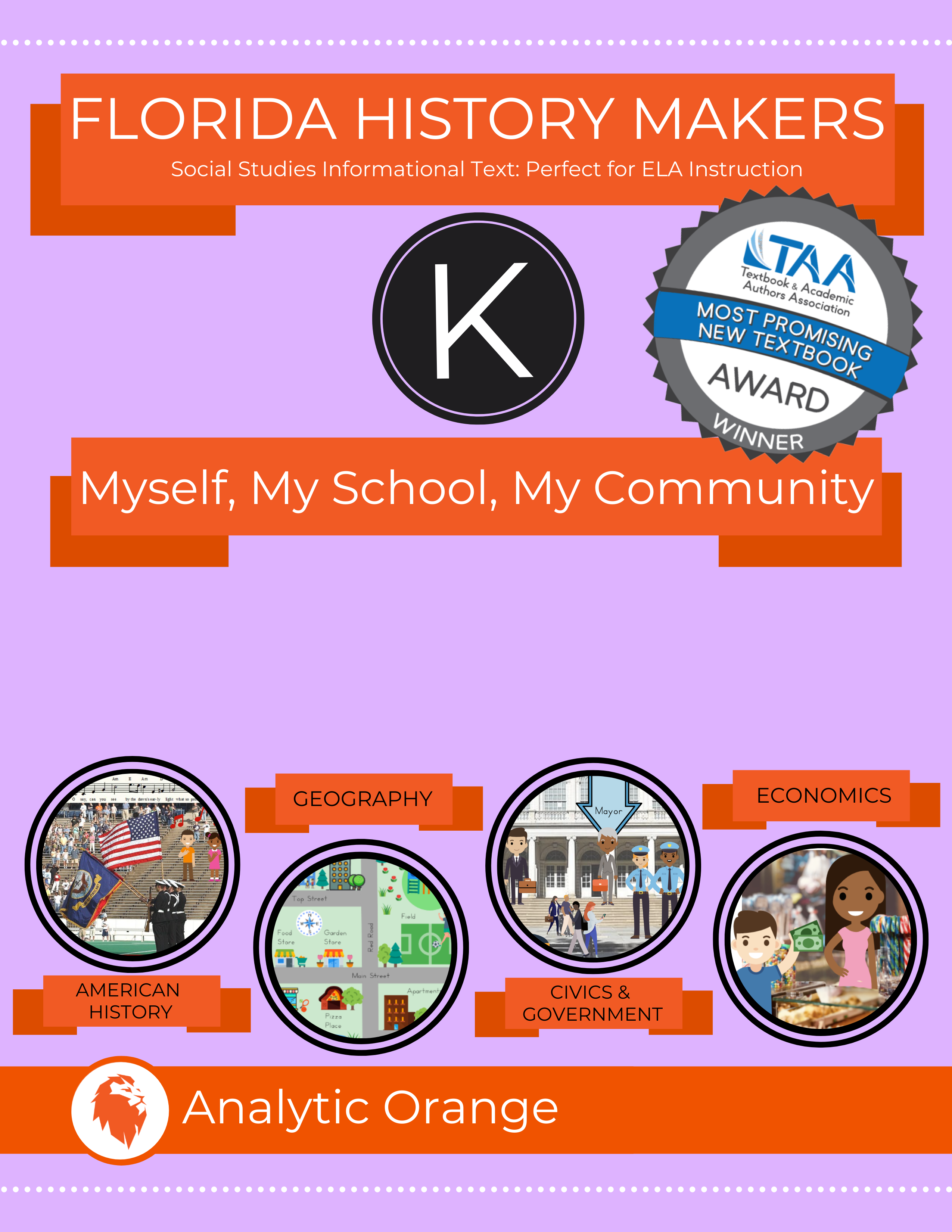 We are proud to announce that the Textbook and Academic Authors Association, which reviews K-12 and College textbooks, selected Analytic Orange’s Kindergarten social studies textbook for this prestigious award!
We are proud to announce that the Textbook and Academic Authors Association, which reviews K-12 and College textbooks, selected Analytic Orange’s Kindergarten social studies textbook for this prestigious award!
Analytic Orange’s Florida History Makers – Kindergarten Social Studies: Myself, My School, My Community, written and developed by Dr. Kim Mogilevsky, Shawn Mabry, M.Ed., Shari Markowitz, Stephanie Mahler, M.A.C.E., and edited by Monica Sherwin, M.A.
What did the expert reviewers say?
-
“charming and should engage the age group”
-
“features engaging graphics and drawings that appeal to children”
-
“offers vivid and helpful SlideShares”
-
“the neuroscience-based lessons are a wonderful strength”
The Textbook and Academic Authors Association (TAAonline.net) is a nationally-recognized professional organization. TAA provides a wide range of professional development resources, events, and networking opportunities for textbook authors and authors of scholarly journal articles and books.
Contact us if you’d like more information about our products, pricing, and promotions! info@analyticorange.com
Follow us on Social Media!
What is Social-Emotional Learning (SEL)?
Regardless of the cause in behavioral changes in adults and youth in the last twenty to thirty years, some would argue that these descriptors are indicative of a need for stronger social and emotional skills. The learning of these skills is commonly referred to by educators as Social Emotional Learning (SEL) and is defined as the process through which children and adults understand and manage emotions, set and achieve positive goals, feel and show empathy for others, establish and maintain positive relationships, and make responsible decisions (Casel, 2019).
“There is broad agreement among educators, policymakers, and the public that educational systems should graduate students who are proficient in core academic subjects, able to work well with others from diverse backgrounds in socially and emotionally skilled ways, practice healthy behaviors, and behave responsibly and respectfully (Association for Supervision and Curriculum Development, 2007; Greenberg et al., 2003)” (Durlak, Weissberg, Dymnicki, Taylor, & Schwllinger, 2011, n.p.).
The Collaborative for Academic, Social, and Emotional Learning (CASEL) provides a framework identifying five core competencies within three settings.
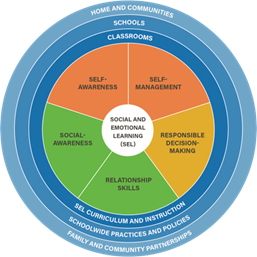 Decades of research found that social and emotional learning incorporating the above five competencies resulted in increased student academic performance 11 percentage points above students who were not in such programs. (Durlak et al., 2011). The social and emotional learning programs also reduced aggression (by as much as one-half) and emotional distress among students, increased helping behaviors in school (prosocial behaviors), and improved positive attitudes toward self and others. Outcomes were immediate and long-lasting (up to three years after intervention) (Schonert-Reichl, Smith, Zaidman-Zait & Hertzman, 2012; Santos, Chartier, Whalen, Chateau & Boyd, 2011; Cain & Carnellor, 2008).
Decades of research found that social and emotional learning incorporating the above five competencies resulted in increased student academic performance 11 percentage points above students who were not in such programs. (Durlak et al., 2011). The social and emotional learning programs also reduced aggression (by as much as one-half) and emotional distress among students, increased helping behaviors in school (prosocial behaviors), and improved positive attitudes toward self and others. Outcomes were immediate and long-lasting (up to three years after intervention) (Schonert-Reichl, Smith, Zaidman-Zait & Hertzman, 2012; Santos, Chartier, Whalen, Chateau & Boyd, 2011; Cain & Carnellor, 2008).
Illinois and Kansas have adopted social and emotional learning standards and have begun implementing three distinct phases of social and emotional learning programs: readiness, planning, and implementation. “The most common problem when implementing SEL programs is a lack of teacher and administrator support for the program (Durlak, et al., 2011).” Vega (2015) noted knowledge-building, developing an SEL framework, ensuring teacher capacity and readiness to implement SEL, ongoing professional development, lesson evaluation and feedback, and systemic monitoring of implementation and outcomes must all be considered when implementing an SEL program otherwise significant setbacks will arise.
References
Cain, G. & Carnellor, Y. (2008). ‘Roots of empathy’: A research study on its impacts on teachers in Western Australia. Journal of Student Wellbeing, 2(1), 52-73. Retrieved from https://www.ojs.unisa.edu.au/index.php/JSW/article/viewFile/168/227
Casel. (2019). What is SEL? [website]. Retrieved from https://casel.org/what-is-sel/
Durlak, J.A., Weissberg, R.P., Dymnicki, A.B., Taylor, R.D., & Schwllinger, K.B. (2011). The impact of enhancing students’ social and emotional learning: A meta-analysis of school-based universal interventions. Child Development, 82(1), 405-432. Retrieved from https://casel.org/wp-content/uploads/2016/01/meta-analysis-child-development-1.pdf
Santos R. G., Chartier M. J., Whalen, J. C., Chateau D., & Boyd, L. (2011). Effectiveness of school-based violence prevention for children and youth: Cluster randomized controlled field trial of the Roots of Empathy program with replication and three-year follow-up. Healthcare Quarterly, 14, 80-91. Retrieved from https://www.longwoods.com/content/22367
Schonert-Reichl, K. A., & Lawlor, M. S. (2010). The effects of a mindfulness-based education program on pre- and early adolescents’ well-being and social and emotional competence (PDF). Mindfulness, 1, 137-151. Retrieved from http://mindup.org/thehawnfoundation/
Vega, V. (2015). Social and emotional learning research review: Avoiding pitfalls. [website]. Retrieved from https://www.edutopia.org/sel-research-avoiding-pitfalls
Instructional Materials Should Reflect the Readers
“If you can see it, you can be it” is an adage educators who work with diverse populations know to be true. How important is it for students who are not white to see high-achieving people who look like them in the instructional materials presented to them in class? What might be the implications for “business as usual” textbook and instructional materials selection mean for students of color?
Oprah’s O Magazine ran a photo-essay titled “Let’s Talk About Race” by Chris Buck in May 2017. Perhaps you have seen the photos in the magazine or reported by CNN, The Huffington Post, or on Tumblr. The three photos show a white girl looking at rows of African American dolls in a store, a white woman serving a Latina woman tea, and several white women providing professional pedicures to Asian women. Did the images cause you to pause and reflect? What does this have to do with instructional materials? Actually quite a bit!
Research has demonstrated the benefits of a culturally diverse curriculum – not just the images, but points of view, too. “The Century Foundation Report” by Wells, Fox, and Cordova-Cobo (2016) stated, “Supporting the growing body of evidence on the educational benefits of diverse classrooms, researchers have found pedagogical value inherent in having multiple vantage points represented in classrooms, helping all students think critically about their own views and develop greater tolerance for different ways of understanding issues.” Dr. Ladson-Billings (1992) noted, “It (culturally relevant pedagogy as an approach) uses the students’ culture to help them create meaning and understand the world. Thus, not only academic success, but also social and cultural success is emphasized.” Diverse perspectives and images in instructional materials are extremely important for academic growth and the social emotional well-being for all students.
The majority of U.S. school teachers are white females according to Education Week’s article published June 5, 2019. Our job as professional educators is to ensure all students reach their highest potential and that includes closing the academic achievement gap for minority students. Don’t rely on your overwhelmed classroom teachers to gather additional resources to supplement the monochromatic/majority (white) instructional materials the district provides. Actively seek out educational publishing companies like Analytic Orange that put inclusivity and minority point-of-view first (not as a counterpoint). “Multicultural education can be taught to all children and is beneficial to all children” (Patrick Coggins, Ph.D., J.D., L.L.D., Jessie Ball, & Shawnrece D. Campbell, Ph.D.).
Does the curriculum your district has purchased and provided to schools reflect the students who will be reading and learning?
References
Ahuja, Masuma. “These Photos Are Meant to Turn Our Racial Assumptions on Their Head.” CNN. May 19, 2017. Accessed June 08, 2019. https://www.cnn.com/2017/05/19/us/race-photo-series-o-magazine-trnd/index.html.
Coggins, Patrick, Ph.D., J.D., L.L.D., and Shawnrece D. Campbell, PhD. “Using Cultural Competence to Close the Achievement Gap.” The Journal of Pan African Studies2, no. 4 (June 2008): 44-59. http://www.jpanafrican.org/docs/vol2no4/2.4_Using_Cultural_Competence_to_Close_the_Achievement_Ga1.pdf.
Ladson-Billings, Gloria. “Toward a Theory of Culturally Relevant Pedagogy.” American Educational Research Journal32, no. 3 (1995): 465-91. doi:10.2307/1163320.
Loewus, Liana. “The Nation’s Teaching Force Is Still Mostly White and Female.” Education Week. February 20, 2019. Accessed June 08, 2019. https://www.edweek.org/ew/articles/2017/08/15/the-nations-teaching-force-is-still-mostly.html.
Staged-Photography. “Staged-photography.” August 19, 2017. Accessed June 08, 2019. https://staged-photography.tumblr.com/post/164362420072/chris-buck-lets-talk-about-race-commissioned-for.
Stuart Wells, Amy, Lauren Fox, and Diana Cordova-Cobo. “How Racially Diverse Schools and Classrooms Can Benefit All Students.” The Century Foundation. April 03, 2017. Accessed June 08, 2019. https://tcf.org/content/report/how-racially-diverse-schools-and-classrooms-can-benefit-all-students/.
Workneh, Lilly, and Lilly Workneh. “These Profound Photos Masterfully Turn Racial Stereotypes On Their Head.” HuffPost. May 18, 2017. Accessed June 08, 2019. https://www.huffpost.com/entry/these-profound-photos-masterfully-turn-racial-stereotypes-on-their-head_n_591dceece4b03b485caf8c6d.










